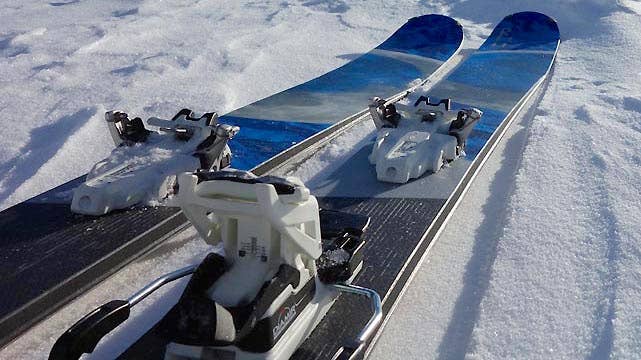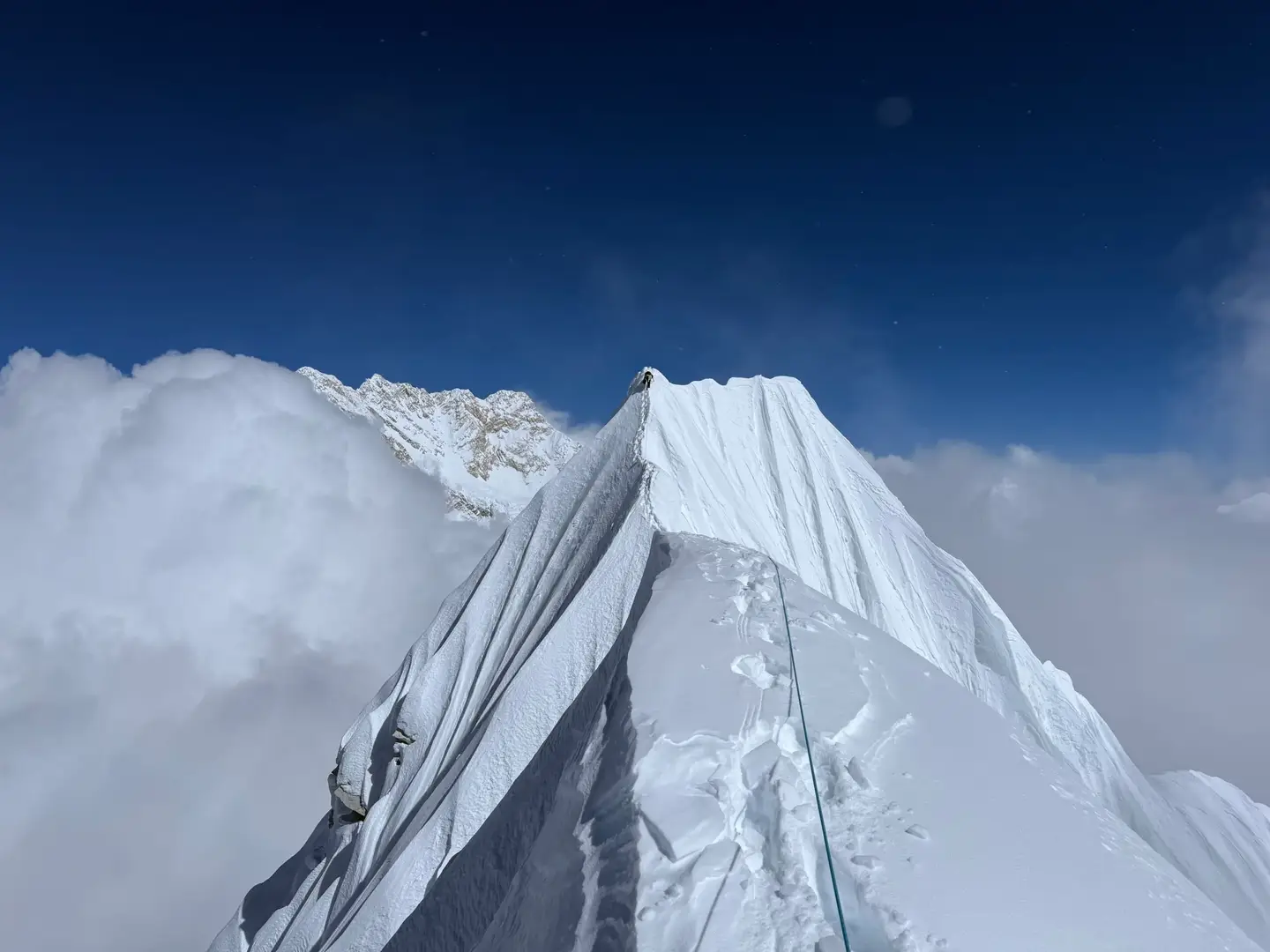

Fritschi’s Vipec Alpine Touring Tech Binding – Teton Tested
Popular Stories
The second year version of Fritschi's Vipec binding.
Check out the Fristchi Vipec bindings at evo.com today.
Reviewed here is Fritschi's entry into the world of the tech bindings; the DIN 12 Vipec. This is Fritschi's second year of the Vipec–a touring-oriented binding designed primarily for backcountry skiing. As opposed to the older Fritschi Freeride frame bindings, where a metal bar links the toe and heel and has to be lifted with each footstep, like all tech bindings the Vipec holds the boot only at the toe in walk mode, and only engages the heel when in ski mode.
Noteworthy design features differentiating the Vipec versus other tech offerings includes laterally adjustable release at the toe in both ski and walk mode, a vertically-releasing heelpiece that glides back & forth on a platform, and a modicum of forward pressure so there's no gap between boot heel and binding heel-piece.
The Vipec is available
from Evo.com and other retailers for a price of $ 559.95. Ski crampons are an extra $99.95.
About The Tester
I’m not a big skier, at just 160 pounds, but do spend 100+ days a season skiing, with most of those days in backcountry. I've had 25 days on the Vipecs with almost all of the days spent in backcountry of Whistler, the Duffey and the B.C. Interior. My skiing is usually in high moisture-content snow. Accordingly, my preference is for bigger skis and relatively stiff boots.
I had the Vipecs mounted on
Rocky Mountain Underground Carbon Apostles and skied them either with a Dynafit Vulcan or a Scarpa F1 Evo. I've had extensive experiences on tech bindings having skied on Dynafits for over 12 years and having tested the Beast, G3's Onyx and various other tech offerings. If you have questions about one versus the other, please ask in the comment section below.
Vipec Specifications and Features

Vipec testing in the Blackcomb backcountry. Lee Lau photo.
The Vipec's tested weight with 120mm brakes is 545 grams (same as official weight). Brake widths available are 82mm, 95mm, 108mm and 120mm, and are a true width, so either buy the right brake or get used to bending them to fit. The brakes can also be removed.
Release values goes from 5 to 12, with RV's adjustable at toe and heel. Speaking of toe release, the toe pins can actually float a set distance side to side before they hit a certain threshold (after a big enough hit) and then flip open to release. This theoretically allows for release even when the ski is hyperflexed –say, when tomahawking. When going into walk mode, you can walk around with the toe lever horizontal or flipped up if you want to up the toe retention when touring. There are bump blocks with different colours (gimmicky) and different heights to actuate the toe release in a forward fall (see the video below). If you're using different boots with different toe profiles, you'll find the bump blocks to be a pain in the ass for setup. Heel release works like an alpine binding based on up-down/fore-aft movements. Because the heel piece floats about 4mm, the ski can flex a bit more, which theoretically mitigates pre-release and the sometimes disconnected feeling one can have when skiing bindings with a heel gap.
The Vipec's ramp angle is decidedly less, and better, than Dynafit's ridiculously old-school offerings, with there only being a 10 mm delta between toe and heel (more on
ramp angle here). That ramp angle means the Vipec has a truly flat tour mode and two climbing bar heights (easily actuated with a pole) of 9 and 13 degrees.

#1 is the adjustable front pin required to accommodate the fact that tech boot manufacturers cannot somehow make the toe pin spacing consistent between them. #2 is the pin locker and improved locking nut designed to prevent the adjustable toe pin from falling out. #3 refers to the black centering jaws designed to make it easier to step into the Vipec toe. #4 is the gimmicky and PITA toe clip. Fritschi photo.
Finally, it's no secret that year 1 versions of tech bindings are plagued by teething problems, and Fritschi's Vipec was no exception. Toe pins fell out. Heel pieces iced up. No amount of waffling that these were isolated circumstances could belie the fact that these did occur. Fortunately, Fritschi has reacted appropriately and made fixes in Year 2's bindings; fixes which are described in the picture above.
Review: Touring With The Vipec

Vipec in touring mode. Lee Lau photo.
For touring, like all tech bindings, the Vipecs beat the pants off all frame bindings. They're lighter and have a more natural stride due to the toe pivot placement. Transitions are simple. All you have to do is use a pole tip or handle to hit the heel piece switch to move the binding forward and/or backwards. This is an especially nice touch when going from ski to walk mode on the flats, where you might be able to scootch or glide to your next destination. Heel risers are also easy to use and simply deployed with a swish of the pole. Although the Vipec is supposed to have sufficient toe retention that one can tour without the toe lever in walk mode, I found that I clicked out easily unless I deployed the toe lever up.
Sign Up for the TGR Gravity Check Newsletter Now
There are nits to pick. I found that it is possible to torque the first heel lifter enough under aggressive cantilevered skinning for the lifter pin to displace from its slot. However, the plastic is so tough I could bend the heel lifter back into the slot. Additionally, Vipec toe boot entry is finicky. There simply isn't a lot of space between the toe pins. More often than not, you have to push the toepiece down with a pole to get a bit more toepin distance so you can insert the boot. Even though ease of toe binding entry was purported to be an improvement over the year 1 design, Fritschi will have to do better in subsequent years. There are alternative ways suggested for entry to the Vipec (see video below) but there's no getting around the fact that the Vipec has substantial fiddle factor compared to the gold standard of even Dynafiddling.
Review: Doing The Downhill

Vipec binding testing in Whistler. Lee Lau photo.
The Vipec skis very well downhill. It skis so well that I would use it for wide skis for slackcountry purposes, i.e. where I was mixing up some inbounds on pow days then ducking outside resort boundaries to ski powder laps.
To expand, Fritschi built in some elasticity into the Vipec's toe by designing the toe pins so they have some lateral motion to allow small micro-hits to be absorbed from ski deflection and accommodate toe side-to-side motion. Some elasticity was also designed into the heel piece by allowing the heel piece to glide some 40mm on a spring-equipped track that keeps the heel piece flush to the boot even when the ski is cambered violently on a big hit.
Check out evo.com's full selection of ski touring bindings by clicking here.
I speculate here, but the toe design coupled with the more secure connection of the heel-boot interface results in a very solid feel when skiing downhill, particularly on hardpack. Gone is the vagueness of Dynafits (no doubt attributable in large part to the heel binding gap) and the constant feeling that one is going to explode off the skis. Anecdotally, I had gone full speed from a soft-snow run into icy moguls again at full speed (didn't see them; I should have been paying attention!). My skis stayed on my feet and the binding connection felt solid. On Dynafits, I would have either rattled out my fillings or double-ejected. On another run inbounds, I subjected the Vipecs to a mogulled flatlight run trying to land on the backside of other moguls. While totally mistiming everything, I compressed into a mogul frontside and then proceeded to fold my legs and fall onto my back and slide downhill a few meters. Again, no pre-release!
It's worthwhile noting that I have had no toepiece pins issues. Another reported issue was icing of the heelpiece which prevented the Vipec properly engaging in ski mode, but this year 2 version has had no such issue. One issue I did find is that brakes were only half-deploying. This was solved by shaving the plastic off the brakes so they did not drag on the ski top sheet and edge before they expanded all the way.
The Bottom Line

While this is not a binding shootout, it's almost impossible to not reference the gold standard (Dynafits) when reviewing a tech binding. To sum it up, I found the
Vipec to be an improvement over Dynafit Comfort/Vertical in terms of downhill feel on hardpack and variable snow (in soft snow, downhill performance differences between the bindings was imperceptible). I found the Vipec to more fiddly in tour mode mainly because it was not as easy to get into as Dynafits. from a durability perspective, I've not been terribly careful with the Vipecs and have had no issues. However, 25 days isn't a terribly long time, so any opinion on durability is only speculative.
More importantly, the binding releases on the Vipec have been predictable, occurring when I've thought that the binding should release. If you want a reasonably light binding with consistent release characteristics, a solid, connected feel on the downhill, and you are willing to tolerate finicky entry, then the
Fritschi Vipec should be considered as a tech touring binding of choice.
Check out the Fristchi Vipec bindings at evo.com today.




